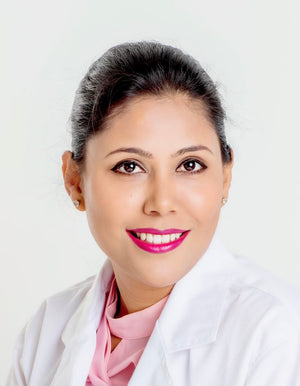Exploring the various acne forms and how to recognise them

Around 90% of adolescents between 16 to 18 struggle with acne in Australia. Although prevalent and natural, acne can negatively impact self-esteem further leading to shrinking confidence.
Acne impacts the perception of your physical appearance and your additional state, increasing the likelihood of editing photos on social media. The good news is treating acne is pretty straightforward!
But before you lump layers of cream or serum, you must identify the type of acne, whether inflammatory or non-inflammatory.
Since each type of acne has a distinct appearance with varying symptoms and remedies, identifying them can be tricky. To help you out, we've created a comprehensive guide to pinpointing the subtypes of acne and how to get rid of them.
Identifying Your Non-Inflammatory Acne
Non-inflammatory acne includes surface-level blemishes that don't cause swelling or redness on your skin. This acne doesn't cause tenderness or discomfort because the pore stays intact.
Therefore, non-inflammatory acne responds comparatively well to over-the-counter treatments.
Let's dive into its subtypes:
Blackheads
Blackheads are blemishes easily identified by their small, dot-like, and black appearance. These acquire the 'black' colour due to the oxidation of the pores exposed to the air.
In dermatology, blackheads are called 'open comedones.' The blemishes are 'open' because the core lacks the usual skin covering despite the sebum and dead cells clogging the pore. Ordinary, blackheads affect individuals with enlarged pores, excess sebum, hormonal changes, bacteria, dead skin cells, and ingrown hairs.
The optimal approach to combat blackheads is to use a salicylic or azelaic acid cleanser and serum or seek an oil-free moisturiser.
Whiteheads
The distinct classification of mild acne, whiteheads form pores when clogged by dead skin cells and sebum. The difference lies in the fact that this pore possesses a thin layer of skin, resulting in a characteristic white bump surrounded by a red halo or red ring.
Whiteheads don’t lead to scarring, but the skin surrounding the blemish may appear tight. It is a pervasive skin condition resulting from dead skin cells, excess sebum production, and bacteria. But because the pores are closed, it's challenging to treat.
However, using adapalene, benzoyl peroxide, and salicylic acid alongside washing your face with lukewarm water and mild soap can alleviate their appearance.
Identifying Your Inflammatory Acne
Inflammatory acne refers to deep-seated, red, and swollen pimples. These tend to occur due to dead skin cells and bacteria that cause clogging or infections.
Unlike its counterpart, inflammatory acne can cause complications like scarring and pitting. On a positive note, once you can identify your skin condition, it’s manageable to treat it.
Cysts
Due to severe bacterial infections, cysts are identified as the largest form of acne These create a painful, red or white lump deep within the skin's surface and can cause red marks or scarring.
The primary cause of cysts is bacteria, while they may also develop due to clogging by bacteria, sebum, and dead skin cells. Moreover, oily skin is the breeding ground for bacterial growth, which is why it occurs in individuals with oily/combination skin or hormonal imbalances.
Since cysts are severe, it's best to leave the treatment to dermatologists and doctors, who may prescribe medicines or recommend surgical removal.
Nodules
Nodules are also a severe type of inflammatory acne, distinguished by their big size, rugged appearance, and lack of soreness. These develop when clogged and infected pores endure irritation and occur deep within the skin.
Moreover, nodules can be painful and lead to scarring and dark spots. Since nodules are severe and deep under the skin, you can't treat them with home remedies.
Instead, your doctor or dermatologist may prescribe oral medication to prevent the growth of modules by minimising the pores.
Papules
Differing from nodules, papules are a moderate acne type occurring when bacteria reach oil or dead skin under the skin's surface. These elements lead to the breakdown of walls around pores and are sensitive to touch.
Papules appear solid, raised, pink, or red, and the skin around them becomes inflamed. But the pores of this acne lack a visible centre and pus. The best way to treat this blemish is to use a mild face wash, gentle lotions and makeup, and skincare products formulated for sensitive skin.
Moreover, you can add benzyl peroxide to your skincare routine to combat mild to severe acne.
Pustules
What's the first thing that comes to mind when you hear the word pimple? What you're picturing is a pustule. This acne appears as larger, tender bumps with defined circular centres similar to whiteheads.
But unlike whiteheads, these have a red ring around the white or yellow head of the pore and contain yellowish-white pus due to bacterial infection. In addition, these are painful to touch and look more inflamed than a whitehead.
While it's tempting to pop them, pustules can sometimes leave scars. So, you can try using benzyl peroxide or salicylic acid to treat them. Your doctor may also recommend antibiotics to soothe acne.
Journey to Healing: Discovering the Acne Treatment?
Coping with acne, regardless of its type can be a challenging ordeal. But with a robust preventive skincare routine, you can target the root cause of your acne and prevent them.
Here are some effective approaches to eradicate acne:
- Gently cleanse your face with a gel cleanser targeted for sensitive and oily skin. Ensure you select one that does not disrupt your skin's pH balance. You can try DRSQ’s Clarifying Cleanser to clean your pores deeply.
- Massage several drops of salicylic acid serum to unclog pores and combat imperfections. You can give Acne Clear serum a shot. It comes with a 0.5% Retinaldehyde.
- Follow up using an anti-acne moisturiser rich in vitamin C or niacinamide. That way, you can alleviate the appearance of dark marks.
- Use a face sunscreen with an SPF of 50+ to protect your skin from harmful UV rays.
The Bottom Line
Battling acne can be an emotional experience, but distinguishing the type of acne can help you take the first step towards combating it. We recommend discussing with your dermatologist to diagnose the blemishes on your skin.
Your dermatologist might offer expert advice on which ingredients to use and avoid. In moderate to severe cases, they may prescribe over-the-counter medications or surgery. Take the right step to acne treatment with the acne starter kit, including cleanser, serum, and moisturiser.



